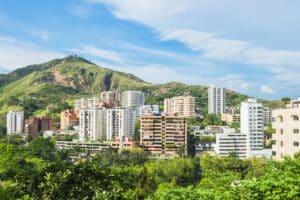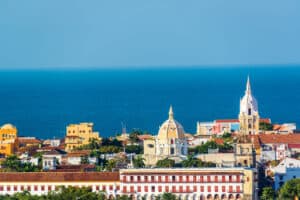Colombia welcomed a record-breaking 5 million tourists in 2023, securing a spot on CNN’s list of “Best Destinations to Visit in 2023.”
However, some international travel advisories are urging tourists to be very cautious while visiting Columbia, and others even suggest that tourists reconsider travel. Let’s learn more about the country’s comprehensive safety situation so you can travel equipped with knowledge.
Are you planning a last minute trip to Colombia? We’ve put together all the resources you’ll need for a fun & safe travel:
🛌 Best & Safest Places to Stay in Colombia:
👉 Casa La Cartujita – Airport shuttle, Exceptional breakfast, Free WiFi
👉 GHL Arsenal Hotel – City view, Room service, Fitness centre
👉 Sonesta Hotel Ibagué – Spa and wellness centre, Restaurant, Bar
👉 Hotel Campestre – Fitness centre, Family rooms, Airport shuttle
⛱️ Fun Activities & Tours in Colombia:
👉 Bogotá Bike Tour
👉 Museo Pablo Escobar
👉 Cartagena ATV Tour
🚗 Best & Safest Colombia Transportation Services:
👉 Airport Pickup Service – Welcome Pickups
👉 Rent a Car – DiscoverCars
🙏 Stay Safe While Travelling:
👉 Safetywing (for medical insurance)
👉 VisitorsCoverage (for trip insurance)
Is Colombia Safe?

Colombia is not dangerous, but we can’t say it’s completely safe either.
Recent reports of violent crimes and a surge in robberies triggered international travel advisories to level up their precautions, sticking pins on a Colombia map marking places to avoid and sharing tips on how to stay safe.
As a traveler, you aren’t likely to find yourself in the areas where danger lurks. Instead, you’ll be enjoying touristic cities like Cartagena, where visitors are welcomed and protected.
However, you’re still in Colombia. If you don’t remain vigilant and smart about situations, things can go south. Here’s an overview of the safety situation:.
- International travel advisories: Level 2—visit with a high degree of caution
- Criminality score: 7.75, second highest globally
- Most committed crimes: Violent crime, petty thefts, drug-related offenses, cyber crimes, drink spiking
- Most dangerous departments: Antioquia and Valle del Cauca
- Cities with the most robberies: Pasto, Bogotá, and Barranquilla
- City with the lowest thievery rate: Medellín
- Areas to avoid at all cost: Arauca, Caquetá (excluding Florencia), Cauca (excluding Popayan), Chocó (excluding Nuquí, Bahía Solano, and Capurganá), areas within 31 miles (50km) of the Venezuela border (excluding Cúcuta), 62 miles (100km) of the Panama border, 31 miles (50km) of the Ecuador border (excluding the Ipiales border crossing), Norte de Santander (excluding Cúcuta), The Port of Tumaco, and Buenaventura
- All but essential travel: Antioquia, Córdoba, Guainía, Guaviare, the city of Cúcuta, Meta (excluding Villavicencio and Caño Cristales), Nariño (excluding Pasto and Ipiales), Putumayo, Valle del Cauca (excluding Buga, Cali, and Palmira), Vaupés
- Public transportation safety: Not safe, opt for a taxi
- Beach safety: Generally safe; stick to beaches with lifeguards
- Shark attacks: Rare
- Common natural disasters: Hurricanes, earthquakes, tsunamis, and volcanic eruptions
- Carbon monoxide poisoning: Possible, bring a portable CO detector
- Police presence: Police officers and military units are plenty, but not enough to combat all crime
- Medical care quality: The best hospitals are located in the bigger cities like Cali, Bogotá, and Medellín
- Climate: Tropical
- Best time to visit: December to March
Travel Advisory for Colombia
The Canadian, NZ, UK, and Australian travel advisories don’t discourage visitors to Colombia, but do urge them to exercise a “High Degree of Caution” (Level-2 safety category), whereas the US travel advisory goes a step further, urging travelers to “Reconsider Visiting” (Level-3 safety category).
The main concern in Colombia is violent crime—but violent crime mostly occurs in relation to cartels. So if you visit Colombia, do not travel to:
- Arauca
- Caquetá (excluding Florencia)
- Cauca (excluding Popayan)
- Chocó (excluding Nuquí, Bahía Solano, and Capurganá)
- Areas within 31 miles (50km) of the Venezuela border (excluding Cúcuta)
- Areas within 62 miles (100km) of the Panama border
- Areas within 31 miles (50km) of the Ecuador border (excluding the Ipiales border crossing)
- Norte de Santander (excluding Cúcuta)
- The Port of Tumaco
- The city of Buenaventura
Additionally, avoid all but essential travel to:
- Antioquia
- Córdoba
- Guainía
- Guaviare
- The city of Cúcuta
- Meta (excluding Villavicencio and Caño Cristales)
- Nariño (excluding Pasto and Ipiales)
- Putumayo
- Valle del Cauca (excluding Buga, Cali, and Palmira)
- Vaupés
The listed high-crime areas are distant from the tourist hotspots of Bogotá, Medellín, Cartagena, and Cali—so there’s no reason to visit these beautiful destinations.
The main safety concerns in tourist hotspots are robberies and cybercrime. Colombia saw an uptick in online dating incidents, where tourists get intentionally intoxicated by their meet-ups and subsequently robbed.
So—be careful who you meet online! Your safety is worth the extra care.
A Comprehensive Look at Colombia Crime Rates
Colombia has a 7.75 criminality score—the second highest globally after Myanmar.
The most common crime in Colombia is theft, with nearly 427,830 cases in 2022. Out of them, nearly 47,000 were vehicle thefts—3,000 more than the previous year.
If we consider individual cities, Pasto has the highest thievery rate in Colombia (10.6). Bogotá comes in second spot (7.3), and Barranquilla in third (4.7). Cucuta is notorious as the city with the highest home burglary rate (3.7).
On the brighter side, Monteria recorded the lowest thievery rate in 2022 (1.2), while Medellín enjoys the lowest house theft rate in the whole of Mexico (less than one).
| Safety Concerns | Crime Rate | Status |
| Overall Crime Level | 72.81 | High |
| Increase in Crime (Past 3 Years) | 68.07 | High |
| Home Break-Ins and Thefts | 46.62 | Moderate |
| Mugging and Robbery | 70.66 | High |
| Car Theft | 52.82 | Moderate |
| Theft from Vehicles | 62.00 | High |
| Personal Attacks | 52.97 | Moderate |
| Verbal Insults | 42.15 | Moderate |
| Racial, Ethnic, Gender, or Religious-Based Attacks | 22.25 | Low |
| Drug Use and Dealing | 64.52 | High |
| Property Crimes (Vandalism and Theft) | 65.67 | High |
| Violent Crimes (Assault and Armed Robbery) | 72.26 | High |
| Corruption and Bribery | 80.97 | Very High |
| Safety Walking Alone in Daylight | 53.17 | Moderate |
| Safety Walking Alone at Nighttime | 26.20 | Low |
Source: Numbeo, 2024 data 2024 data based on 1,263 contributors.
Police Presence in Colombia
Colombia’s police force and military units are widespread, patrolling airports, roads, government buildings, highways, and popular tourist spots. While they’ll do their best to help, combating high crime rates may affect response times. Be aware of corruption issues as well—a study found that 11% of respondents had been asked for a bribe by police officers.
Public Transportation Safety in Colombia
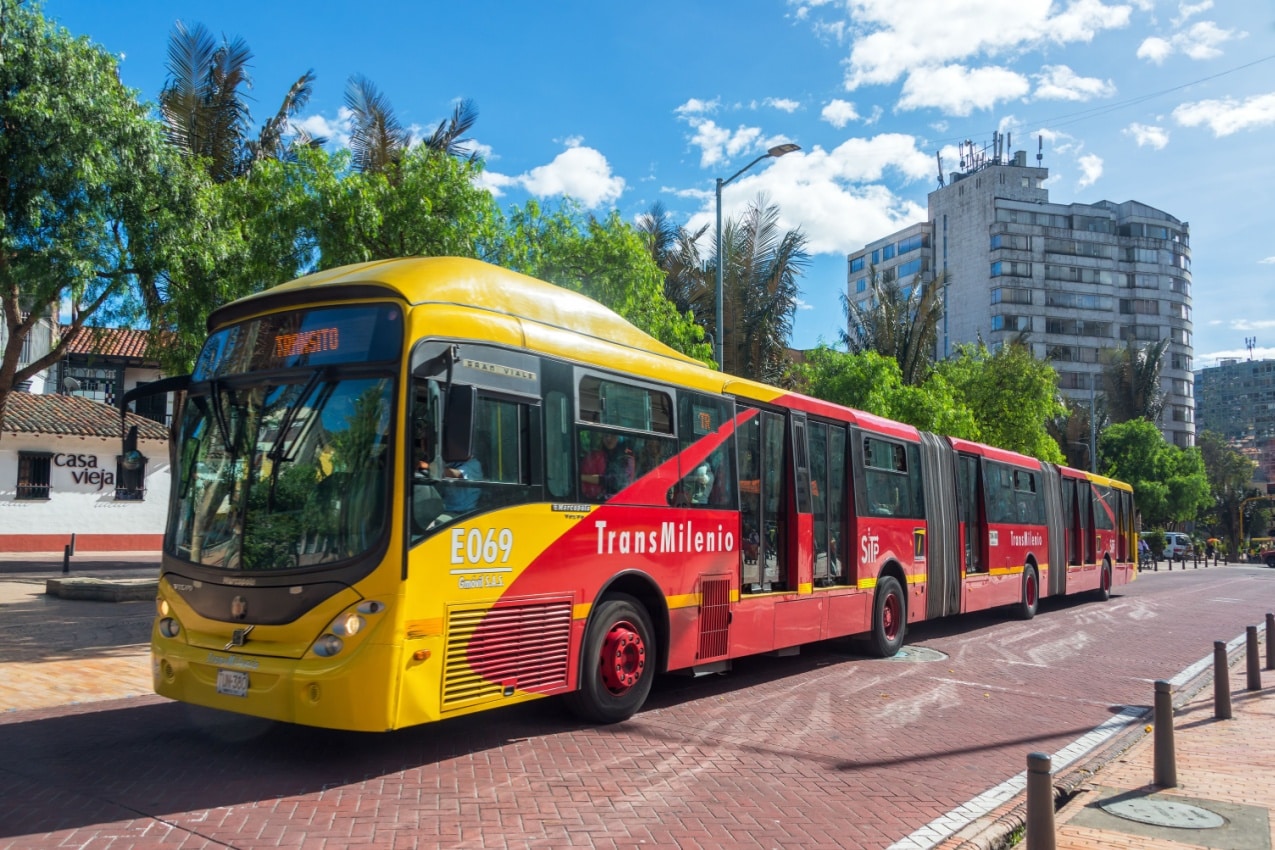
Public transportation such as buses isn’t very safe, but cabs could be a safer option.
Buses are common targets for petty theft like bag snatching, stealing your money or your phone, or even something more extreme like armed larceny.
Taxis are a safer option, recognizable by their yellow color and “Servicio Publico” plates. Negotiate fares beforehand to avoid getting overcharged. Ride-sharing services like Tappsi are another option—they work similarly to Uber (Download the app here: Google Play/ Apple Store).
Beware of unlicensed taxis, as they are unreliable, may rip you off, or even commit a violent crime. If you have to hail a cab from the street (rather than call one), choose a cab with license plates, avoid an occupied one, and share the plate number with someone you trust through your phone.
Medical Care Quality in Colombia
Healthcare in Colombia varies widely, with top-notch hospitals mainly in larger cities:
- Fundación Valle Del Lili, Cali
- Fundación Santa Fe De Bogota, Bogotá
- Hospital Pablo Tobón Uribe, Medellín
- Fundación Hospitalaria San Vicente De Paul, Medellín
- Hospital Universitario San Ignacio, Bogotá
- Clínica Del Country, Bogotá
- Clínica De Marly S.A, Bogotá
- Clinica La Colina SAS, Bogotá
- Médico Imbanaco De Cali, Cali
- Hospital General De Medellín, Medellín
Pharmacies are plenty, many open 24/7, offering over-the-counter medications at affordable prices. Some reputable pharmacies include:
Consider travel health insurance for financial security, ensuring coverage at your chosen Colombian healthcare facility. Explore options like VisitorsCoverage, Insured Nomads, and SafetyWing.
Is It Safe to Travel Solo in Colombia?
Safety in numbers holds true here, and going solo, even in seemingly safe spots, makes you seem like an easier target.
Consequently, we wouldn’t say that Colombia is a safe destination for solo travel. You never know when you’re going to end up in the wrong place at the wrong time, especially in a foreign land where authorities are dealing with a rise in crime.
So, we agree with the US travel advisory on this one—reconsider visiting Colombia. Or you could just join a travel group!
If you still want to go alone, then avoid going out at night, especially at nightclubs and bars—the threat of drink spiking is more serious when you’re on your own!
Perils of Nature: The Risk of Natural Disasters in Colombia
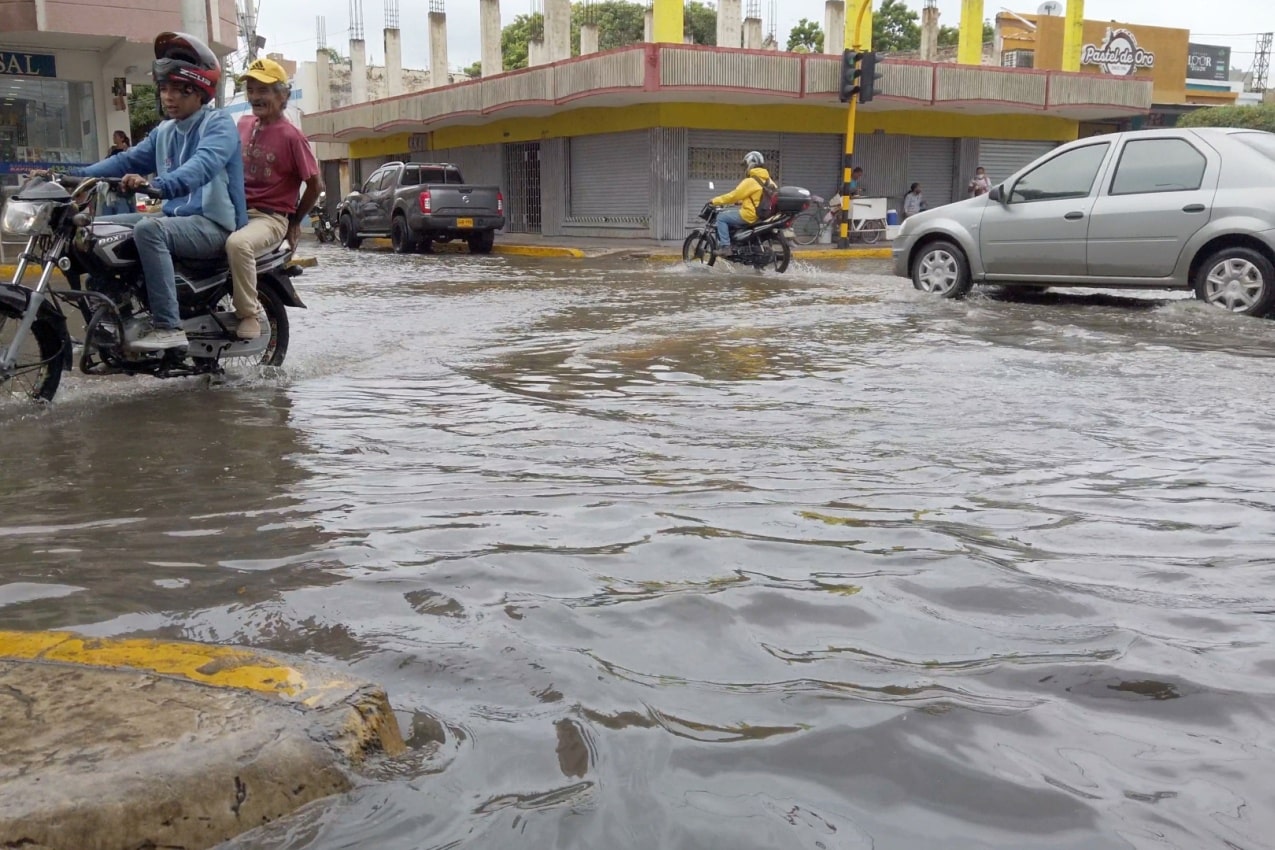
Colombia is at risk of hurricanes, earthquakes, volcanic eruptions, and tsunamis. Don’t worry—none of these are frequent or life-threatening!
Hurricanes
Hurricane season spans from early June to late November, averaging about four hurricanes annually.
Colombia typically dodges direct hits, but the aftermath can unleash powerful winds, rain, and flooding, especially along the Caribbean Coast.
The most powerful hurricane in 2023 was Franklin. It hit with winds reaching 51.6 mph (83 km/h) near Uribia on August 21, 2023, and was classified as a tropical storm hurricane by the Saffir-Simpson scale.
If you book your vacation in inland cities, like Medellín, you needn’t worry about hurricanes. However, coastal towns like Cartagena do experience some side effects.
Keep tabs on the National Hurricane Center for real-time updates.
Earthquakes
Colombia experiences large earthquakes, surpassing a magnitude of 7.0—however, they occur infrequently given the country’s size.
Recent notable seismic activity includes:
- February 19, 8:38 pm: 4.6-magnitude earthquake near Bucaramanga
- February 15, 1:27 pm: 4.7-magnitude earthquake near Riosucio
- February 7, 9:36 pm: 4.4-magnitude earthquake southeast of San Lorenzo de Esmeraldas
The most powerful recorded earthquake in Colombia happened on December 12, 1979. It registered 7.7 on the Richter scale and triggered a destructive tsunami.
In case of a tremor, remember to drop, cover, and hold on. Seek refuge under sturdy structures until shaking ceases. If outdoors, find an open area away from buildings and trees.
If you’re at the coast and witness water pulling back, this is an early sign of a tsunami. Immediately move to higher ground.
Follow updates on recent tremors in Colombia on the Volcano Discovery website.
Tsunamis
Tsunamis are a rare occurrence in Colombia, with only four storms classified as tsunamis in this South American country since 1906.
The most recent wave hit in 2017, towering at 8 meters, fortunately without any recorded human casualties. The most infrastructurally damaging impact, however, followed the 1979 earthquake with a 7.7 magnitude. The resulting tsunami reached heights of almost 20 feet (around 6 meters).
Tsunamis primarily affect coastal towns. So if you are vacationing somewhere inland, you have nothing to worry about.
For more information about tsunamis, visit the International Tsunami Information Center.
Volcanic Eruptions
Colombia sits within the seismic hotspot known as the Pacific Ring of Fire and has 10 volcanoes, six of which are still considered active:
- Dona Juana
- Galeras
- Nevado del Ruiz
- Nevado del Tolima
- Purace
- Sotara
In the spring of 2023, Nevado del Ruiz showed concerning activity, triggering a yellow eruption warning. Fortunately, the heightened activity subsided in the following months, and the volcano didn’t erupt.
The last volcanic eruption in Colombia occurred on November 20, 2008, from the Hulia volcano. Thankfully, this volcano is now inactive. The most powerful eruption in recent history unfolded on November 13, 1985, courtesy of the Ruiz Volcano.
Stay informed about volcanic activity in Colombia on the Global Volcanism Program.
Beware the Silent Threat: Carbon Monoxide Poisoning in Colombia
Colombian accommodations are not required to install CO detectors, so protection from this invisible gas is not guaranteed.
In 2024, a Dutch tourist was found unresponsive in a Medellín hotel, and the same happened to a US tourist in 2023 and 2019. The suspected culprit in all cases was CO poisoning.
This gas usually leaks from poorly maintained or improperly vented appliances—so if there’s no CO detector to set off an alarm where you’re staying, the gas can poison you.
We recommend taking matters into your own hands—bring a portable CO detector with you. It’s a simple, budget-friendly device that can save your life.
The early symptoms of CO poisoning are similar to those of the flu, so if you experience a headache, dizziness, or begin vomiting, you may have been exposed to CO. Get out of the room and seek medical attention. CO exposure can have serious consequences.
Serenity by the Shore: The Safety of Colombia Beaches
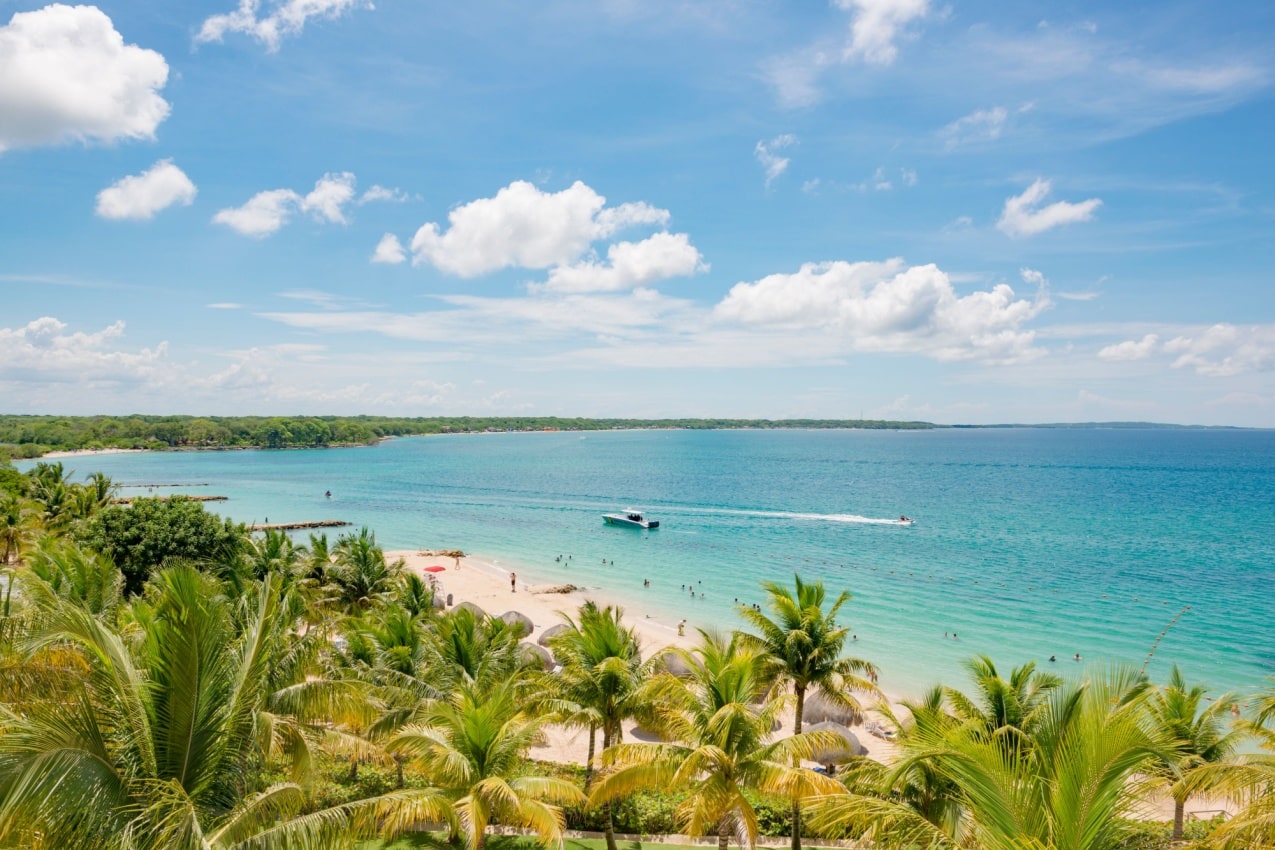
Colombia’s coastal area is generally safe.
The city of Cartagena is one of the most popular (and safe) coastal destinations in Colombia. The beaches have lifeguards on duty from June to September, but you may not be able to spot them in the more secluded areas.
If you can’t spot lifeguards at the beach, ask the locals if it’s safe to swim or check for beach flags. Colors signal safety levels:
- Red Flag: Don’t swim due to strong waves and currents
- Yellow Flag: Swim cautiously, as waves or currents may pose a challenge
- Green Flag: All clear, the sea is calm
- Purple Flag: Caution, potential presence of sharks or other dangerous marine life
Though shark incidents are rare, there was a report of a hammerhead shark swimming close to the shoreline of a beach in Isla de San Andres in 2024, hunting for manta rays.
Stay close to crowds when you swim, as sharks tend to avoid areas crowded with swimmers. Night swims are not the best idea, as sharks typically hunt after sunset. Plus, lingering on the beach after nightfall may increase the risk of becoming the target of crime.
Colombia Weather Patterns: What to Expect
Columbia has a tropical climate, which means it’s balmy year-round—between 67°F to 87°F (about 19.4°C–30.6°C), rarely dipping below 65°F or rising above 92°F (about 18.3°C–33.3°C).
The sunny stretch begins in June and ends in October, with August being the sunniest month, boasting a 40% chance of clear skies.
The cloudy season begins in October and continues until the end of May. March takes the lead as the cloudiest month, with an overcast sky 83% of the time.
The rainy season is March to mid-December, with April having the most rainy days—17.3 on average. Meanwhile, November is the rainiest month, with an average rainfall of 5.7 inches (about 14.5 centimeters).
The dry season spans from mid-December to early March. January enjoys the driest days, with an average of 8.4 days free from precipitation. August has the least rain, with an average rainfall of 1.8 inches (about 4.6 centimeters).
From late September to July, Colombia is pretty humid—about 36% of the time. May is the most humid month, clocking in at 29.2 humid days. On the flip side, August has the least, only 5.2 muggy days.
Colombia enters its windy season from mid-May to late September. August is the windiest month, with an average speed of 6.0 miles per hour (about 9.7 kilometers per hour). November is the calmest, boasting a gentle wind speed of 3.3 miles per hour (about 5.3 kilometers per hour).
Monthly Average Temperatures in Colombia
| Month | Fahrenheit (°F) | Celsius (°C) |
| January | 76 | 24.4 |
| February | 76 | 24.4 |
| March | 76 | 24.4 |
| April | 75 | 23.8 |
| May | 75 | 23.8 |
| June | 75 | 23.8 |
| July | 75 | 23.8 |
| August | 77 | 25 |
| September | 77 | 25 |
| October | 75 | 23.8 |
| November | 74 | 23.3 |
| December | 74 | 23.3 |
Source: WeatherSpark, 2024 data
When Is the Best Time to Visit Colombia?
The best time to visit Colombia is between December and March.
Dry weather, endless sunshine, and balmy temperatures make this period prime for exploration. Plus, this is the liveliest time of year in Colombia, with plenty of tourists and activities to enjoy.
One of the most fun spectacles is the Carnival season, which takes place in February or early March. Barranquilla hosts the most exuberant carnival, rivaling the one in Rio.
Keep in mind that the best months to visit are also the most expensive, so book early to get a good deal. Still, we believe that it’s better to pay extra and join the bustling crowd than risk standing out in quieter times.
How to Stay Safe in Colombia
- Leave the jewelry at home
- Carry a photocopy of your passport and hide the original in a secure place
- Write down your accommodation and destination addresses in case you get lost and barely speak Spanish
- Use Waze for travel routes; it works like Google Maps but with better accuracy
- If lost, seek help from someone in uniform—like security guards or police officers
- Always lock the doors of your taxi or any car you’re in
- Only carry the money you need for the day
- Stay home after dark and avoid lonely streets
- Never leave your drink unattended; this is a general common-sense precaution, as drink-spiking can occur anywhere in the world
- Don’t walk and talk on your cell phone in the street; take calls in a shop or a restaurant
- Pay attention to advice from locals—they know the safe spots and the risky ones
- Don’t show your money or ID to anyone claiming to be the police; ask to verify currency at the station
- If you are being physically threatened, don’t resist muggers; hand over what they want and report the incident promptly
- If you get hungry at night, don’t go out—opt for food delivery from services like Uber Eats and Glovo
- Stay updated on safety; read local news from reliable sources like El Tiempo and Colombia Reports
- Register at the Smart Traveler Enrollment Program (STEP) for emergency assistance
- Book accommodations on trustworthy sites like Booking and AirBnb; check reviews regarding the owner and security features
Emergency Numbers
- National emergency number: 123
- Tourist Police: (1) 3374413
- Metropolitan Police: 112
- Fire Department: 119
- Medical Emergencies: 125
- Traffic Police: 127
- Toxicological Centre: 136
- Civil Defense: 144
- DAS (Security Department): 153
- DIJIN (Directorate of Judicial Police): 157
- GAULA (Kidnapping and Extortion Squad): 165
No Dar Papaya!
As a parting tip, we’ve got a Colombian saying for you: “No dar papaya,” which means don’t put yourself in a vulnerable situation where you could be taken advantage of.
But hey, given that we’ve shared all these safety tips, you’ll be well-prepared, vigilant, and far from danger! The exception is if you’re traveling solo, in which case we suggest that you postpone your vacation for safer times or join a travel group, as safety in numbers.
We wish you a safe and fantastic journey in Colombia!
